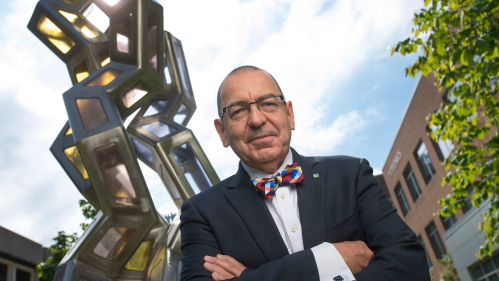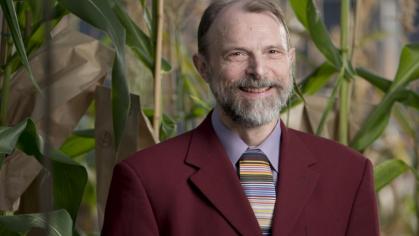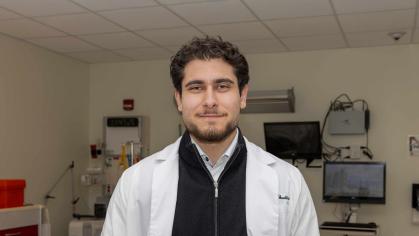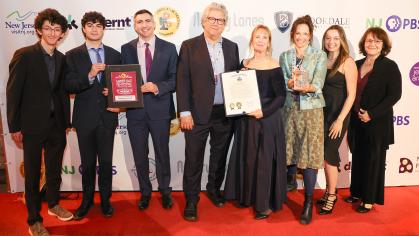Stephen K. Burley, University Professor and Henry Rutgers Chair, has been named Fellow of the American Crystallographic Association (ACA), a distinction awarded to members by their peers for demonstrating a high level of excellence in scientific research, teaching, service, leadership and personal engagement in the broader world of crystallography and science.
“I am honored to join the ACA Fellow ranks with Rutgers faculty members Helen Berman and Eddy Arnold and multiple Noble Laureates. Recognition from one's peers is enormously meaningful,” said Burley. “As the international scientific society representing structural biologists and other structural scientists working in North America, the American Crystallographic Association is making great contributions to training the next generation of crystallographers (both macromolecular and small molecule) and cryo-electron microscopists. Rutgers has been strong in structural biology for many decades. It’s great to have a seat at the table in this international organization,” he added.
Stephen K. Burley is an expert in structural biology, molecular biophysics, computational biology, data science, structure-guided/fragment-based drug discovery, and clinical medicine/oncology. Throughout his research career, Burley has shown insight and creativity in choosing and designing systems for structural studies. Burley is also the director of the RCSB Protein Data Bank, the founding director of the Rutgers Institute for Quantitative Biomedicine, and a member of the Rutgers Cancer Institute of New Jersey, where he co-leads the Cancer Pharmacology Research Program.
“As an internationally distinguished scientist and researcher in both the academic and the private sector, Stephen has been a key driver of Rutgers excellence in interdisciplinary biological and biomedical research. He has also been leading the open access Protein Data Bank (PDB), a foundational tool for understanding human health and disease and driving translational biomedicine,” said S. David Kimball, senior vice president for research at Rutgers.
Burley and his team recently published peer-reviewed papers documenting the role of the PDB in facilitating discovery and early stage development of nearly 90% of the new drugs approved recently by the US Food and Drug Administration 2010-2016. More than 70% of the 54 new small-molecule anti-neoplastic agents approved 2010-2018 were the product of the structure-guided drug discovery campaigns, which relied on open access to PDB structures of the target proteins of these new drugs. Very much in the news of late, PDB data were central by the success of Google DeepMind’s effort using artificial intelligence to accurately predict structures of proteins not represented in the public archive.
A Fellow of the ACA is a member whose efforts on behalf of the advancement of crystallography or its applications that are scientifically or socially distinguished. Among the areas in which nominees may have made significant contributions are research; teaching; technology; services to professional societies; administration in academia, industry, and government; and communicating and interpreting science to the public. Fellows are elected annually by the current group of Fellows.
As a chaired professor at The Rockefeller University and an investigator in the Howard Hughes Medical Institute, Burley made significant contributions to our understanding of gene transcription in eukaryotes, including three-dimensional (3D) structures of the TATA boxing binding protein and the Myc oncoprotein, both bound to promoter DNA. He also carried out structural studies of eukaryotic proteins that control initiation of messenger RNA (mRNA) translation in eukaryotes (e.g., eIF4E bound to the mRNA cap and the poly-A binding protein bound the 3’ end of mRNA). While working in industry, Burley was chief scientific officer and senior vice-president for research at SGX Pharmaceuticals, Inc., where he and his colleagues built an industry-leading high-throughput platform for structure-guided drug discovery and crystallographic screening of fragments of drug like molecules bound to target proteins. These same tools are now used by every major pharmaceutical company worldwide, including Eli Lilly and Co. which acquired SGX in 2008 and employed Burley as a Distinguished Lilly Research Scholar before his return to academe.
Stephen’s productivity as a structural biologist includes 1,238 PDB depositions that represent nearly 1% of its current total of ~170,000 structures. At SGX and Lilly, he and his colleagues determined a comparable number of proprietary structures, most of which remain inside the company firewall. In 2003 under Burley’s leadership, SGX Pharmaceuticals deposited into the PDB the first 3D structure of a SARS-CoV-1 viral protein (its main protease, a key drug target). He took the helm of the RCSB PDB in 2014.
At Rutgers, Burley worked with University leadership to establish the Rutgers Cryo-Electron Microscopy and Nanoimaging Facility, located on the ground floor of the Proteomics Building on the Busch Campus. He is inspired by “the revelations that come from ‘seeing’ the individual atoms of biological macromolecules and understanding how form (3D structure) determines function.” “These biomolecular structures are exquisitely beautiful in their own right,” added Burley, a passionate angler who enjoys both fresh and saltwater fly fishing here in New Jersey and around the world.




